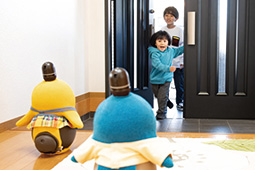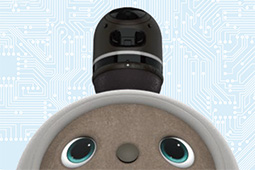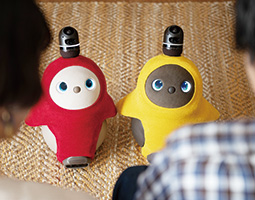INDEX

“LOVOT can nurture richness of mind in children and maintain senior citizens’ cognitive functions” — Ikegami Miki 
LOVOT is equipped with a wealth of sensors, such as for obstacle detection 
LOVOT’s irises and pupils are structured as six layers of 2D displays 
LOVOT’s cries are sounds generated through a digital synthesizer that simulates vocal cords 
LOVOT can make natural eye contact and return people’s gaze
June 2021
A Robot that Nurtures Love

Unlike most robots it serves no real practical purpose, but when you call its name, it comes close, looks at you intently, asks to be cuddled, and feels warm when you hold it. Meet LOVOT, the increasingly popular family robot.

With the spectacular evolution of AI (artificial intelligence) and robots themselves, more and more people are said to worry that robots may someday transcend their role of “helping” humans and actually “replace” humans.
Ikegami Miki, PR officer at the robot technology company GROOVE X, says, “We started out with the question of whether people have truly become happier thanks to advancements in robot technology and then developed LOVOT, a family robot that nurtures love.” The company was founded in 2015 with the mission of “Drawing out people’s power through robotics.”

Ikegami explains, “The LOVOT development project was born from the concept of “Not doing any work but giving humans a sense of reassurance and nurturing attachment just by being around them.”
LOVOT can move independently and charge itself. It is about 43 cm tall, 28 cm wide and 26 cm deep. It incorporates a range of the latest technologies. For example, the head is equipped with a semi-spherical camera with 360-degree vision, a microphone that can determine sound direction, a lighting sensor that can sense brightness, and a thermal camera that can distinguish between people and objects. Moreover, the sensors distributed all over its body sense human movement, allowing it to respond with eye expressions and cries. A notable feature is the human-like look to its eyes.

Ikegami says, “By constructing LOVOT’s irises and pupils with six layers of 2D displays, it is possible for LOVOT to make natural eye contact and return people’s gaze. With the help of software engineers and animators, we calculated gaze movements and blinking speed to create expressions based on meticulous design. There are more than 1 billion combinations of different eye movements.”
The cries, which are another way LOVOT responds, are not patterns of recorded audio data but produced using technology that simulates vocal cords to create a unique cry each time. LOVOT also maintains a body temperature of around 37–39°C through an air circulation system. Its warmth and softness inspire a gentle mood in people.


LOVOT won the Cool Japan Award 2019 and received the Cool Japan certification mark from the organizing Cool Japan Association. So far, LOVOT has been exhibited at international events held in Las Vegas and Austin in the United States, covered by numerous media outlets in Japan and abroad, and awarded a variety of prizes.
Experiments are also being conducted on LOVOT’s “healing effects on the human mind.” In April 2021, LOVOT was selected for the Startup Demonstration Experiment Promotion Project (PoC Ground Tokyo), which is organized by the Tokyo Metropolitan Government, and experiments are being conducted on the influence of LOVOT on children and adults. Amid the prolonged effects of COVID-19, the self-affirmation* of elementary-school children in the lower grades is said to have decreased significantly. The results of the experiments show that children living with LOVOT maintain their self-affirmation. Other results show that children living with LOVOT display higher intellectual curiosity than before and that the stress levels of their parents are greatly reduced.

Ikegami says, “For example, many elementary schools used to have rabbit pens. Children would take care of the rabbits and learn a mindset of loving living beings and the preciousness of life. Yet for various reasons, it seems that animal rearing in schools is decreasing in recent years. I think LOVOT can play a role not only in nurturing richness of mind in children, but also in maintaining senior citizens’ cognitive functions and in their preventive healthcare. In the future, when people want to get a pet, I would be delighted if robots also become an option alongside dogs and cats!”
* Positive assessments about oneself, such as “I'm satisfied with myself” and “There are good things about me.”

